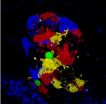Prompt, appropriate medical care for dislocated shoulder injuries
2014-12-01
(Press-News.org) ROSEMONT, Ill.--Prompt and appropriate treatment of a dislocated shoulder--when the head of the upper arm bone (humerus) is completely knocked out of the shoulder socket (glenoid)--can minimize risk for future dislocations as well as the effects of related bone, muscle and nerve injuries, according to a literature review appearing in the December issue of the Journal of the American Academy of Orthopaedic Surgeons (JAAOS).
The shoulder has the greatest range of motion of any joint in the human body and is the most common site for a full or partial dislocation. Shoulder dislocations are classified as "traumatic" or "atraumatic." Up to 96 percent of dislocations are traumatic, occurring most often during contact sports or when someone falls onto an outstretched hand. Atraumatic dislocations--when the shoulder starts to slip part way out without trauma--can cause limited shoulder movement in multiple directions.
In 2011, shoulder dislocations accounted for 175,641 emergency department visits in the U.S., although some patients choose to reset the joint without any medical assistance.
"We do not recommend self-setting of shoulder dislocations," says Richelle Takemoto, MD, an orthopaedic surgeon with Kauai Medical Clinic/Wilcox Memorial Hospital. Dr. Takemoto and her co-authors recommend immediate medical attention for a dislocated shoulder that includes radiographic images before and after reduction (resetting of the shoulder) to check for related fractures and other musculoskeletal injuries.
The cause of injury, the presence of an associated fracture and/or nerve injury, and the difficulty in resetting the shoulder all contribute to a patient's outcome.
"Acute shoulder dislocations can be effectively managed by closed reduction maneuvers," says lead study author Thomas Youm, MD, clinical assistant professor, New York University Hospital for Joint Diseases. "There are a plethora of closed reduction techniques available for relocation of a dislocated shoulder. A thorough understanding of these reduction techniques as well as immobilization strategy and rehabilitation regimens can successfully treat dislocations of the shoulder and hopefully prevent the need for surgery."
If you have dislocated your shoulder:
Promptly seek orthopaedic care--at latest, within one week from injury--to ensure the best diagnosis and treatment.
Monitor for possible nerve damage pre- and post-reduction surgery.
Once the ligaments have healed, appropriate counseling is needed to rehabilitate the injury and to prevent frozen shoulder. Among seniors, persistent weakness in the shoulder should be checked for a possible rotator cuff tear(s).
By the numbers
Forty percent of shoulder dislocation patients have an associated structural (ligament or muscle) injury.
One of three shoulder dislocation patients also has a rotator cuff tear.
Males ages 10 to 20 have the highest rate of shoulder dislocation.
Recurrent dislocations are most likely to occur within two years after an initial dislocation, most often in patients younger than 20.
Six of 10 younger patients developed instability over two years and seven of 10 over five years following a dislocated shoulder.
Men are more likely to have recurrent instability following a shoulder dislocation than women.
INFORMATION:
December 2014 Full JAAOS Table of Contents
Acute Management of Shoulder Dislocations
Surgical Treatment of Flail Chest and Rib Fractures
Antibiotic Stewardship in Orthopaedic Surgery: Principles and Practice
Identification of Common Gait Disruption Patterns in Children With Cerebral Palsy
Update on Zone II Flexor Tendon Injuries
Three-dimensional Intraoperative Imaging Modalities in Orthopaedic Surgery: A Narrative Review
Elbow Arthroscopy: Indications, Techniques, Outcomes, and Complications
For more AAOS news, visit the News Bureau
Follow AAOS on Twitter
Follow AAOS on Facebook
Google+
Orthopaedic surgeons restore mobility and reduce pain; they help people get back to work and to independent, productive lives. Visit ANationInMotion.org to read successful orthopaedic stories.
More information About the AAOS
Disclosures: From the Department of Orthopaedic Surgery, NYU Hospital for Joint Diseases, New York, N.Y. (Thomas Youm, MD, and Brian Kyu-Hong Park, MD) and the Bone and Joint Center at Kauai Medical Clinic, Wilcox Memorial Hospital, Lihue, Hawaii (Richelle Takemoto, MD).
Dr. Youm or an immediate family member is a member of a speakers' bureau or has made paid presentations on behalf of and serves as a paid consultant to Arthrex. Neither of the following authors, nor any immediate family member has received anything of value from or has stock or stock options held in a commercial company or institution related directly or indirectly to the subject of this article: Dr. Takemoto and Dr. Park.
J Am Acad Orthop Surg 2014; 22: 1-11 http://dx.doi.org/10.5435/JAAOS-22-12-001.
Contacts
Kayee Ip
Phone: 847-384-4035
Lauren Pearson Riley
Phone: 847-384-4031
ELSE PRESS RELEASES FROM THIS DATE:
2014-12-01
This news release is available in German. Ideally, diamonds consist of pure carbon. But natural diamonds always contain defects. The most researched defects are nitrogen-vacancy centers comprising a nitrogen atom and a vacancy. These might serve as highly sensitive sensors or as register components for quantum computers. However, until now it has not been possible to extract the optically stored information electronically.
A team headed by Professor Alexander Holleitner, physicist at the TU München and Frank Koppens, physics professor at the Institut de Ciencies ...
2014-12-01
Conflicting evidence about the extent to which men's semen quality declines with age--likely lowering their fertility--is being cleared up by new University of Otago, New Zealand, research that has collated and reviewed data from 90 previous studies from around the world.
After conducting a systematic review and meta-analysis of the studies' data, researchers from the University's Departments of Zoology and Anatomy found consistent age-related declines in semen volume and sperm performance and increases in malformed and DNA-damaged sperm. Semen quality is regarded as ...
2014-12-01
Singapore--Scientists at A*STAR's Genome Institute of Singapore (GIS), in collaboration with local clinicians and colleagues in the USA, have identified a biomarker which is strongly associated with triple negative breast cancer (TNBC), a highly aggressive carcinoma that often has early relapse and metastasis following chemotherapy. The newly identified biomarker, a gene called RASAL2, provides a target for developing new therapeutics designed to treat this often deadly disease.
TNBC is deadly because, unlike other types of breast cancers such as estrogen receptor (ER) ...
2014-12-01
Personalized medicine uses methods of molecular analysis, especially genetic sequencing and transcription, in order to simultaneously identify genetic mutations to evaluate each individual's risk of contracting a given disease. It seems that there is more than a single mechanism at hand, as proven by the work of a team of geneticists at the University of Geneva's (UNIGE) Faculty of Medicine, and the Swiss Institute for Bioinformatics (SIB). They have sequenced the RNA of 400 pairs of twins; with this information, they can quantify the roles of both genetic and environmental ...
2014-12-01
HOUSTON -- (Dec. 1, 2014) - Most genes are inherited as two working copies, one from the mother and one from the father. However, in a few instances, a gene is imprinted, which means that one copy is silenced. This is called genomic imprinting. If the active copy is mutated, then disease results, even though the silenced gene copy may be normal.
Angelman syndrome, which causes learning difficulties, speech problems, seizures, jerky movements and an unusually happy disposition, results when a gene inherited from the mother in a particular area of chromosome 15 is mutated ...
2014-12-01
PHILADELPHIA-- Chronic kidney disease (CKD) affects at least one in four Americans who are older than 60 and can significantly shorten lifespan. Yet the few available drugs for CKD can only modestly delay the disease's progress towards kidney failure. Now, however, a team led by researchers at the Perelman School of Medicine at the University of Pennsylvania, has found an aspect of CKD's development that points to a promising new therapeutic strategy.
"We found that a defect in energy production in affected kidney cells plays a key role in CKD development," says Katalin ...
2014-12-01
"I can't get the memories out of my mind!... I am right back in Vietnam, in the middle of the monsoon season at my guard post. My hands are freezing, yet sweat pours from my entire body...I smell a damp sulfur smell. Suddenly I see what's left of my buddy Troy, his head on a bamboo platter, sent back to our camp by the Viet Cong."i
This veteran of the US army, who served in Vietnam, has intense flashbacks of his decapitated friend whenever he hears a clap of thunder, touches a bamboo mat, or sees an Oriental woman. Although the traumatic incident happened decades ago in ...
2014-12-01
A new study* that challenges the prevailing view of how bowel cancer develops in the large intestine is published today in Nature Medicine.
Cancer Research UK scientists have discovered that bowel cancer may not be restricted to starting its journey in the stem cells in the lining of the intestines as previously thought.
The researchers, based at the Wellcome Trust Centre for Human Genetics, studied a hereditary faulty gene which can cause bowel cancer in middle age. The faulty gene causes normal cells to behave like immortal stem cells and develop tumours of their ...
2014-12-01
Many of the complex computer models which are used to predict climate change could be missing an important ozone 'feedback' factor in their calculations of future global warming, according to new research led by the University of Cambridge and published today (1 December) in the journal Nature Climate Change.
Computer models play a crucial role in informing climate policy. They are used to assess the effect that carbon emissions have had on the Earth's climate to date, and to predict possible pathways for the future of our climate.
Increasing computing power combined ...
2014-12-01
This news release is available in French. Micronutrient malnutrition affects more than 2 billion people. Researchers working at the Crop Development Centre at the University of Saskatchewan are seeking long term solutions to help to alleviate the increasing micronutrient malnutrition problem by enriching food grains with essential micronutrients through breeding and appropriate management practices, collectively known as biofortification.
Chickpea (Cicer arietinum L.) is considered an excellent whole food as source of dietary proteins, carbohydrates, micronutrients ...
LAST 30 PRESS RELEASES:
[Press-News.org] Prompt, appropriate medical care for dislocated shoulder injuries

